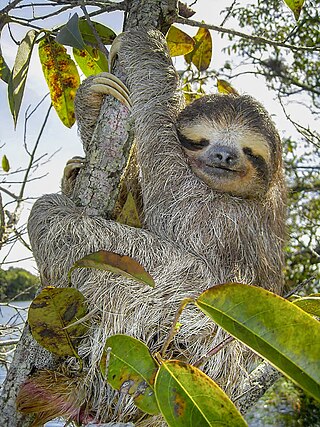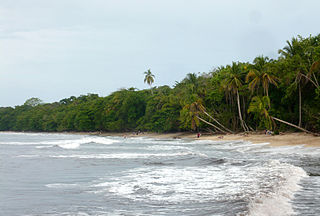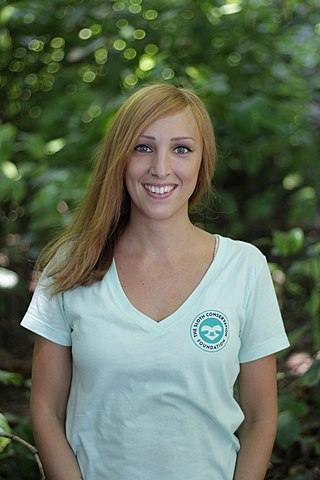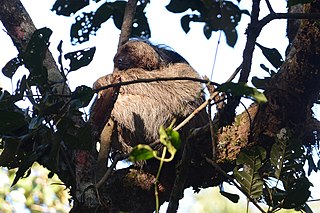
The wildlife of Costa Rica comprises all naturally occurring animals, fungi and plants that reside in this Central American country. Costa Rica supports an enormous variety of wildlife, due in large part to its geographic position between North and South America, its neotropical climate, and its wide variety of habitats. Costa Rica is home to more than 500,000 species, which represent nearly 5% of the species estimated worldwide, making Costa Rica one of the 20 countries with the highest biodiversity in the world. Of these 500,000 species, a little more than 300,000 are insects.

The maned sloth is a three-toed sloth that is native to South America. It is one of four species of three-toed sloths belonging to the suborder Xenarthra and are placental mammals. They are endemic to the Atlantic coastal rainforest of southeastern and northeastern Brazil, located in the states of Espírito Santo, Rio de Janeiro and Bahia. Each of the individuals within the species are genetically distinct with different genetic makeup.The maned sloth is listen under Vulnerable (VU) according to the IUCN Red List and have a decreasing population trend.

Manuel Antonio National Park is a small national park in the Central Pacific Conservation Area located on the Pacific coast of Costa Rica, just south of the city of Quepos, Puntarenas, and 132 km (82 mi) from the national capital of San José. Established in 1972, the local community sought conservation to prohibit development of the natural environment for tourist attraction. They also protested the beach restrictions on locals by foreign owners. With a land area enumerating 1,983 ha, it is the smallest of any Costa Rican national park. The park caters to as many as 150,000 visitors annually, and is well known for its beautiful beaches and hiking trails. In 2011, Manuel Antonio was listed by Forbes as among the world's 12 most beautiful national parks.

The brown-throated sloth is a species of three-toed sloth found in the Neotropical realm of Central and South America.

Hoffmann's two-toed sloth, also known as the northern two-toed sloth is a species of sloth from Central and South America.

Jessore Sloth Bear Sanctuary is situated in the Banaskantha district formerly under Palanpur State in the Indian state of Gujarat at the Gujarat-Rajasthan border. It was declared as a sanctuary in May 1978, covering an area of about 180 square kilometres (69 sq mi), principally for protection of the sloth bear, which is now categorized as "Vulnerable A2cd+4cd;C1 ver 3.1" on the IUCN Red List. Their numbers are declining in the wild and they are threatened with extinction.

Cahuita National Park is a terrestrial and marine national park in the Caribbean La Amistad Conservation Area of Costa Rica located on the southern Caribbean coast in Limón Province, connected to the town of Cahuita. It protects beaches and lowlands and attracts tourists and other visitors who are able to snorkel in the protected marine area which contains the coralline reefs, as well as being a nesting ground for sea turtles. It covers a land area of 2,732 acres (1,106 ha), and a marine area of 55,200 acres (22,300 ha). February through April typically have the best underwater visibility. This is also one of the nicest and least developed beaches in Costa Rica.

Choloepus is a genus of xenarthran mammals of Central and South America within the monotypic family Choloepodidae, consisting of two-toed sloths, sometimes also called two-fingered sloths. The two species of Choloepus, Linnaeus's two-toed sloth and Hoffmann's two-toed sloth, were formerly believed on the basis of morphological studies to be the only surviving members of the sloth family Megalonychidae, but have now been shown by molecular results to be closest to extinct ground sloths of the family Mylodontidae.

The three-toed or three-fingered sloths are arboreal neotropical mammals. They are the only members of the genus Bradypus and the family Bradypodidae. The five living species of three-toed sloths are the brown-throated sloth, the maned sloth, the pale-throated sloth, the southern maned sloth, and the pygmy three-toed sloth. In complete contrast to past morphological studies, which tended to place Bradypus as the sister group to all other folivorans, molecular studies place them nested within the sloth superfamily Megatherioidea, making them the only surviving members of that radiation.

Sloths are a Neotropical group of xenarthran mammals constituting the suborder Folivora, including the extant arboreal tree sloths and extinct terrestrial ground sloths. Noted for their slowness of movement, tree sloths spend most of their lives hanging upside down in the trees of the tropical rainforests of South America and Central America. Sloths are considered to be most closely related to anteaters, together making up the xenarthran order Pilosa.

The pygmy three-toed sloth, also known as the monk sloth or dwarf sloth, is a species of sloth in the family Bradypodidae. The species is endemic to Isla Escudo de Veraguas, a small island off the Caribbean coast of Panama. The species was first described by Robert P. Anderson of the University of Kansas and Charles O. Handley Jr., of the Smithsonian Institution in 2001. The pygmy three-toed sloth is significantly smaller than the other three members of its genus, but otherwise resembles the brown-throated three-toed sloth. According to Anderson and Handley Jr., the head-and-body length is between 48 and 53 centimetres, and the body mass ranges from 2.5 to 3.5 kg.
The mammalian order Pilosa, which includes the sloths and anteaters, includes various species from the Caribbean region. Many species of sloths are known from the Greater Antilles, all of which became extinct over the last millennia, but some sloths and anteaters survive on islands closer to the mainland.

Tortuguero National Park is a national park in the Limón Province of Costa Rica. It is situated within the Tortuguero Conservation Area of the northeastern part of the country. Despite its remote location, reachable only by airplane or boat, it is the third-most visited park in Costa Rica. The park has a large variety of biological diversity due to the existence within the reserve of eleven different habitats, including rainforest, mangrove forests, swamps, beaches, and lagoons. Located in a tropical climate, it is very humid, and receives up to 250 inches (6,400 mm) of rain a year.

The Sloth Institute Costa Rica is a small, not-for-profit organization based in Manuel Antonio, close to Manuel Antonio National Park, Costa Rica, dedicated to the rescue and rehabilitation of sloths. It often takes in orphaned or injured sloths, which require care. Through the work of the team, the sloths are rehabilitated and released back into the wild.
The Sloth Sanctuary of Costa Rica is a privately owned animal rescue center located near the city of Cahuita. The Sanctuary is dedicated to the rescue, rehabilitation, research, and release of injured or orphaned sloths. Tours of the Sanctuary are offered to the public.

Kids Saving the Rainforest (KSTR) is a Costa Rica–based non-governmental non-profit 501(c)(3) organization founded in 1999 to plant trees in depleted areas of the country, and to rescue, rehabilitate and, when possible, release the animals who live in these forests. Since its inception, Kids Saving the Rainforest has planted or is in the process of planting nearly 100,000 trees and rescued and rehabilitated 3,000 wild animals, two-thirds of which have been released back into the wild.

Rebecca Cliffe is a British zoologist and one of the leading experts on sloth biology and ecology. She is the Founder and Executive Director of The Sloth Conservation Foundation and author of the book Sloths: Life in the Slow Lane with photographs by award-winning wildlife photographer Suzi Eszterhas.

The Rio Negro-Rio San Sun mangroves ecoregion covers a series of small of discontinuous mangrove forests on the Caribbean Sea coast of Costa Rica, from a small portion inside the border with Nicaragua in the west to the border with Panama in the east. The coast on this stretch is a flat, alluvial plain, and mangroves are only a small part of a diverse patchwork of local habitats including swamps, mixed rainforests, coastal lagoons, sea grass beds, and sandy beaches. Much of the territory is "blackwater river" in character - slow-moving channels in wooded swamps with water stained by decayed matter. These mangroves are periodically damaged by hurricanes, such as in 1988 from Hurricane Joan, but are able to regenerate.

The southern maned sloth is a three-toed sloth species.





















